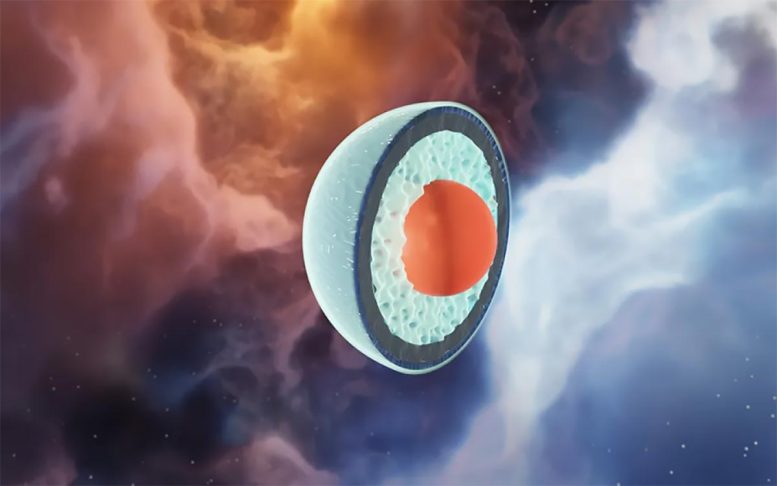
Artist’s impression of the different layers inside a massive neutron star, with the red circle representing a sizable quark-matter core. Credit: Jyrki Hokkanen, CSC
New theoretical analysis places the likelihood of massive neutron stars hiding cores of deconfined quark matter between 80 and 90 percent. The result was reached through massive supercomputer runs utilizing Bayesian statistical inference.
Neutron star cores contain matter at the highest densities reached in our present-day Universe, with as much as two solar masses of matter compressed inside a sphere of 25 km in diameter. These astrophysical objects can indeed be thought of as giant atomic nuclei, with gravity compressing their cores to densities exceeding those of individual protons and neutrons manyfold.
These densities make neutron stars interesting astrophysical objects from the point of view of particle and nuclear physics. A longstanding open problem concerns whether the immense central pressure of neutron stars can compress protons and neutrons into a new phase of matter, known as cold quark matter. In this exotic state of matter, individual protons and neutrons no longer exist.
”Their constituent quarks and gluons are instead liberated from their typical color confinement and are allowed to move almost freely,” explains Aleksi Vuorinen, professor of theoretical particle physics at the University of Helsinki.
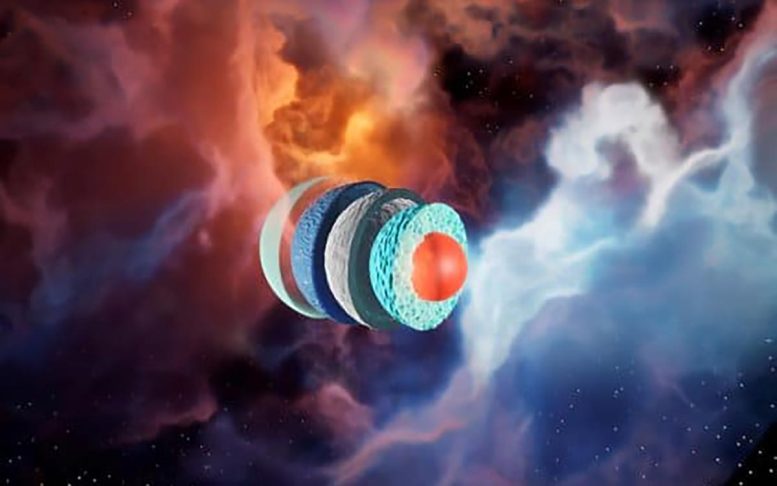
Artist’s impression of the different layers inside a massive neutron star, with the red circle representing a sizable quark-matter core. Credit: Jyrki Hokkanen, CSC
A Strong Phase Transition May Still Ruin the Day
In a new article just published in the journal Nature Communications, a team centered at the University of Helsinki provided a first-ever quantitative estimate for the likelihood of quark-matter cores inside massive neutron stars. They showed that, based on current astrophysical observations, quark matter is almost inevitable in the most massive neutron stars: a quantitative estimate that the team extracted placed the likelihood in the range of 80-90 percent.
The remaining small likelihood for all neutron stars to be composed of only nuclear matter requires the change from nuclear to quark matter to be a strong first-order phase transition, somewhat resembling that of liquid water turning to ice. This kind of rapid change in the properties of neutron-star matter has the potential to destabilize the star in such a way that the formation of even a minuscule quark-matter core would result in the star collapsing into a black hole.
The international collaboration between scientists from Finland, Norway, Germany, and the US was able to further show how the existence of quark-matter cores may one day be either fully confirmed or ruled out. The key is being able to constrain the strength of the phase transition between nuclear and quark matter, expected to be possible once a gravitational-wave signal from the last part of a binary neutron star merger is one day recorded.
Massive Supercomputer Runs Using Observational Data
A key ingredient in deriving the new results was a set of massive supercomputer calculations utilizing Bayesian inference – a branch of statistical deduction where one infers the likelihoods of different model parameters via direct comparison with observational data. The Bayesian component of the study enabled the researchers to derive new bounds for the properties of neutron-star matter, demonstrating them to approach so-called conformal behavior near the cores of the most massive stable neutron stars.
Dr. Joonas Nättilä, one of the lead authors of the paper, describes the work as an interdisciplinary effort that required expertise from astrophysics, particle and nuclear physics, as well as computer science. He is about to start as an Associate Professor at the University of Helsinki in May 2024.
”It is fascinating to concretely see how each new neutron-star observation enables us to deduce the properties of neutron-star matter with increasing precision.”
Joonas Hirvonen, a PhD student working under the guidance of Nättilä and Vuorinen, on the other hand, emphasizes the importance of high-performance computing:
”We had to use millions of CPU hours of supercomputer time to be able to compare our theoretical predictions to observations and to constrain the likelihood of quark-matter cores. We are extremely grateful to the Finnish supercomputer center CSC for providing us with all the resources we needed!”
Reference: “Strongly interacting matter exhibits deconfined behavior in massive neutron stars” by Eemeli Annala, Tyler Gorda, Joonas Hirvonen, Oleg Komoltsev, Aleksi Kurkela, Joonas Nättilä and Aleksi Vuorinen, 19 December 2023, Nature Communications.
DOI: 10.1038/s41467-023-44051-y

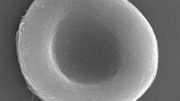
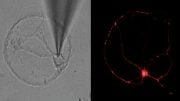



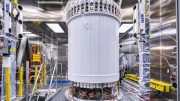

“The remaining small likelihood for all neutron stars to be composed of only nuclear matter requires the change from nuclear to quark matter to be a strong first-order phase transition, somewhat resembling that of liquid water turning to ice.”
I didn’t expect the complication of quark matter cores in neutron stars. But it is exciting both because if recent work is correct it can exist and it implies the phase transition between nuclear and quark matter is a continuous second-order phase transition.
The latter has cosmological implications since after the universe leaves the inflation era it likely undergoes at least two phase transition more, that of the here studied strong force quark plasma to nucleon plasma transition at higher energies and then the electroweak force transition that results in a normal matter we recognize. If both these phase transitions are second-order they don’t form observable “bubble” unconformities but explain why the universe has universal [sic!] properties of forces and particles.
The first phase transition between the cold inflation and the hot big bang eras are of course a first-order discontinuous “latent heat” potential energy releasing and bubble universe forming transition. At least in the inflation theories that best reflect our current observations of a simple scalar inflation field.
I’ll also point to the timely release of an effective field theory for quark plasmas in QCD, which is primarily concerned with He-4 but in the press release discuss similar implications:
“Quarks and nucleons inside nuclei interact with each other via the strong nuclear force. This force has an intriguing property known as confinement. This means scientists can only observe groups of quarks bound together, but never an individual quark by itself. In other words, quarks are said to be “confined.” It is also difficult to describe confinement or even define it precisely using theoretical tools.
This work, using vortex properties to distinguish quark liquids from nucleon liquids, addresses this longstanding problem. It suggests that there is a precise sense in which dense quark liquids are not confining while nuclear liquids are confining.
Whether nuclear matter is distinct from quark matter, in other words separated by a phase transition, is an old question in the study of strong interactions, specifically the theory of quantum chromodynamics (QCD). Similarly, scientists have asked whether or not it is possible to provide a sharp definition of confinement.”
[“A dense quark liquid is distinct from a dense nucleon liquid”, US Department of Energy]
Oops. Seems I suggested the phase transitions in the wrong order. The electroweak phase transition – which gives particles mass – happens at ~ 150 GeV temperature [half the Higgs field vacuum scale of 246 GeV; “Electroweak scale”, Wikipedia]. The QCD phase transition happens at 3 orders of magnitude below that, at ~ 150 MeV. [“The Cosmological QCD Phase Transition Revisited”, Boeckel et al.]
Pretty sure that’s a dishwasher tablet
“Neutron star cores contain matter at the highest densities reached in our present-day Universe, with as much as two solar masses of matter compressed inside a sphere of 25 km in diameter.” So, is it you don’t believe in black holes or that you believe the interior of black holes are somehow not part our of universe?